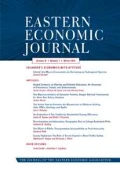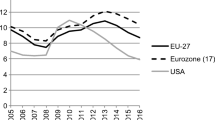Abstract
This paper examines the impact of unemployment on migration. In a theoretical model, we show that unemployment, per se, does not affect migration. Rather, migration only occurs when unemployment shocks force residents to update their expectations of the area’s unemployment rate. Once these expectations change, migration reallocates labor to bring the economy back to equilibrium. Testing this theory, we devise an empirical strategy using state-level data in the US from 2000 to 2010. We estimate that the impact of unemployment shocks outside of expectations is over 25 times greater than the impact of unemployment shocks that are within expectations.
Similar content being viewed by others
Notes
Data are from “Geographic Mobility: 2011,” which is a report from the Census that uses Current Population Survey data.
See Greenwood [1975, 1997] for examples of these tests.
We do not claim that this is the only definition of shocks that are outside or within expectations. Instead, our assumed definition is merely one of many possible definitions. As such, our empirical results should be viewed as supportive but not conclusive evidence on the implications of our theoretical model.
Although this model is written without explicit reference to time, we implicitly assume that all workers living in a region have an equal probability of being employed in the following period, where that probability is equal to one minus the unemployment rate.
Our assumption that residents believe that the regions’ unemployment rate draws are i.i.d. is not innocuous. We could have, instead, assumed that there was some history dependence in people’s expectations (the shock could be characterized by a random walk process, for example). This alternative assumption would imply that all unemployment observations alter people’s expectations. While we do not reject this as a possibility, the goal of our theoretical model is to show that only unemployment observations that change people’s expectations cause migration. As such, we needed a process in which some observations change people’s expectations while others do not.
There are, of course, other factors that affect a resident’s migration decision, including age, family relationships, etc. We abstract from these other factors in order to concentrate on the impact of expected wages.
To be more precise, we have unemployment data by month and by state from 1990 to 2010 and net migration data by month and by state from 2000 to 2010. We use the pre-2000 unemployment data to create our measure of the initial expectations of the state’s unemployment rates for the year 2000. Then, with the algorithm detailed below, we use the unemployment data to update expectations and to determine which unemployment observations are within those expectations and which are outside.
As a robustness check, we considered an alternative approach to forming people’s unemployment expectations. In that approach, we assumed that people updated their expectations each period using a rolling window of past unemployment observations, regardless of whether the unemployment observation was outside or inside expectations. This alternative approach yielded qualitatively similar results to the model we currently present. The results from that alternative approach are available on request from the authors.
As an additional robustness check, we have re-run our empirical tests excluding “gateway” states: states that attract a large number of foreign immigrants who arguably have limited information about local labor market conditions. These gateway states include California, Texas, Illinois, New York, New Jersey, and Florida. The results from these tests are qualitatively similar to our main results presented below, and consequently, we suppress them.
The results are robust to the inclusion of state-level trends.
The goal of this paper is to show that changes in people’s expectations of unemployment influence their migration decisions. As such, we created the simplest possible theoretical model that highlights this channel. In particular, one simplifying assumption was that people believed that the unemployment shock was i.i.d. over time. While we do not literally believe this is the case, it was a helpful simplifying assumption. Thus, when we find that the change in unemployment is significant, we do not believe that this undermines our theory that changes in expectations influence migration decisions, but rather it says that our formulation of expectations is overly simplistic. We believe that more work needs to be done on this topic to better specify expectations.
References
Barrett, Alan, and Irene Mosca . 2013. The Psychic Costs of Migration: Evidence from Irish Return Migrants. Journal of Population Economics, 26 (2): 483–506.
Davies, Paul, Michael Greenwood, and Haizheng Li . 2001. A Conditional Logit Approach to U.S. State-to-State Migration. Journal of Regional Science, 41 (2): 337–360.
Gallin, Joshua . 2004. Net Migration and State Labor Market Dynamics. Journal of Labor Economics, 22 (1): 1–21.
Greenwood, Michael . 1975. Research on Internal Migration in the United States: A Survey. Journal of Economic Literature, 13 (2): 397–433.
Greenwood, Michael . 1997 Internal Migration in Developed Countries in. Handbook of Population and Family Economics, edited by Mark R. Rosenzweig and Oded Stark. Amsterdam: Elsevier, 647–720.
Harris, John, and Michael Todaro . 1970. Migration, Unemployment and Development: A Two-sector Analysis. American Economic Review, 60 (1): 126–142.
Kennan, John, and James Walker . 2011. The Effect of Expected Income on Individual Migration Decisions. Econometrica, 79 (1): 211–251.
Lkhagvasuren, Damba . 2012. Big Locational Unemployment Differences Despite High Labor Mobility. Journal of Monetary Economics, 59 (8): 798–814.
Lowry, Ira . 1966. Migration and Metropolitan Growth. San Francisco: Chandler.
Navratil, Frank, and James Doyle . 1977. The Socioeconomic Determinants of Migration and the Level of Aggregation. Southern Economic Journal, 43 (4): 1547–1559.
Saks, Raven, and Abigail Wozniak . 2011. Labor Reallocation over the Business Cycle: New Evidence from Internal Migration. Journal of Labor Economics, 29 (4): 697–739.
Schwartz, Aba . 1973. Interpreting the Effect of Distance on Migration. Journal of Political Economy, 81 (5): 1153–1169.
Schwartz, Aba . 1976 Migration, Age, and Education. Journal of Political Economy, 84 (4): 701–720.
Sjaastad, Larry . 1962. The Costs and Returns of Human Migration. Journal of Political Economy, 70 (5): 80–93.
Wozniak, Abigail . 2010. Are College Graduates More Responsive to Distant Labor Market Opportunities? Journal of Human Resources, 45 (4): 944–970.
Author information
Authors and Affiliations
Rights and permissions
About this article
Cite this article
Baumann, R., Svec, J. & Sanzari, F. The Relationship between Net Migration and Unemployment: The Role of Expectations. Eastern Econ J 41, 443–458 (2015). https://doi.org/10.1057/eej.2014.44
Published:
Issue Date:
DOI: https://doi.org/10.1057/eej.2014.44




